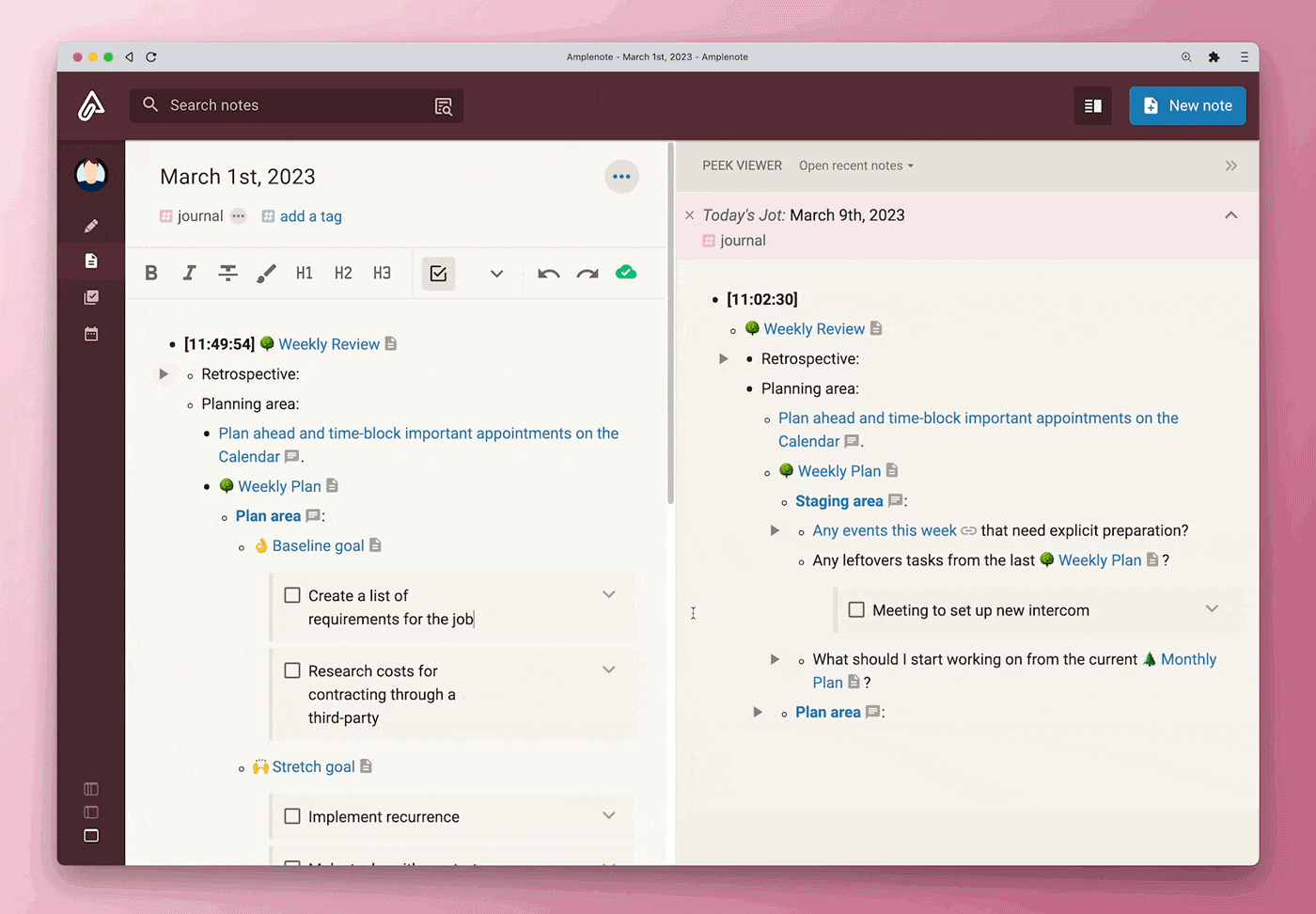
⬅️ Previous sampler |
linkIntroduction
👋 Lucian speaking.
Two Samplers ago we kicked off a mini-series on Reviews and we looked at Journaling and Retrospectives. If you haven't read those blogs yet, I highly recommend that you do that before reading any further.
Today we will cover the second element of the Minimum Viable Review, that is Planning.
Table of contents:
Amplenote Community Samplers like this one are inspired from our Discord and our Reddit, so please consider joining if you're not already there? 😎 Once on Discord, you can sign up for our volunteer Booster Club and we will grant your account a free month of Amplenote Unlimited, extra feature voting privileges and more!
Reading time: 6 minutes
linkRetrospectives feed into Planning
For a quick refresher, in previous Community Samplers we looked at how to divide time into reasonable chunks and perform a "Review" after each chunk. The minimum effort required for a Review is to look at what happened since the previous review (the Retrospective) and plan what should happen before the next one (the Planning).
It turns out that planning and journaling are tightly coupled and enable each other. Journaling helps you log the progress and planning lets you extract a strategy from those logs. To consolidate this synergy, you likely want to journal only about the things that you would like to read again in a week's time. Also, make sure to categorize your journal entries to make them easier to find during your review. The way you choose to group together your logs will influence how your Review is structured.
And finally, before we proceed, a quick footnote on the word "productivity".
linkBuilding up to mindful planning
The second part of the Minimum Viable Review is the Planning phase.
Plans are what give direction to your days. Without a plan, you have to rely on intuition, make more (and poorer) decisions throughout the week and carry more unnecessary information in you head.
Remember that our starting assumption is that it's better to divide and conquer. That is, we prefer breaking down our time into smaller chunks to make it more manageable to retrospect and plan our days and weeks.
During your review, you want to plan everything that should ideally happen by the time the next review comes around. In the next sections, let's look at some examples to illustrate the basics of planning.
link⚙️ Planning is hierarchical
Planning is hierarchical. Your daily plan should be based on what you have planned for the week. Your weekly plan should inherit from your monthly plan. Every smaller plan is there to carry out the larger vision that your past self has set up.
When planning your week, the best starting place is to consider the list of leftover tasks from the previous week, the agenda of events for the current week and the bigger Monthly Plan that you created. Here's how such a template might look like in your Amplenote notebook:
Planning: Staging area: Any leftovers tasks from the last 🌳 Weekly Plan? Any events this week that I need to prepare for? What should I complete from the current 🌲 Monthly Plan? |
Stick around till part 4 of this series for a complete template you can use in your own notebook. |
Your "staging area" is where you list out all of the possible candidates for tasks and projects that you could take on this week. If you're like most people, the list of tasks that you could do is always longer than the list of tasks you can actually do. So, use the staging area to get a quick overview of your obligations and arrange them accordingly.
The 3 best sources of potential tasks for the week will always be: (1) leftover tasks that weren't done last week, (2) events and obligations this week that require preparing and (3) items from the plan you created for the running month.
link⚙️ You are bad at making estimations

How much time do you reckon it would take to finish writing your thesis? What about fixing that bug your colleague reported yesterday?
Sometimes we over-estimate how long something will take if we're not intimately familiar with the domain or we find a shortcut we weren't aware of. And while that's not ideal, the consequences for finishing something earlier than forecasted are often negligible.
By contrast, if you're a notorious under-estimator, that can come with an abundance of ramifications. Especially if your angle is to "be more productive", the psychological tendency shifts towards "wanting to complete more things off the to-do list". To that end, if your daily plan includes all of the things that should get done today, you're likely setting yourself up for disappointment. Instead, multiply your best guess by a factor of 3 or even 4. What does that mean?
Well, let's say you're planning the next 8 hours of your day:
Plan for the next 8 hours: Research the topic for the blog post Outline the structure Write the first draft Make the first editing pass Add formatting and images |
If no unexpected problems arise and you don't find yourself 60-minutes deep into an unrelated Wikipedia rabbit hole, it's certainly plausible to complete that list in 8 hours. And if you don't complete it, just carry over the remaining tasks for the next day, no problem 👍.
But in most real-life scenarios, there is at least one stakeholder relying on you for an estimation. In those cases, a good estimation will cover those branches of the future that may work against you and your plan.

So, if you need to plan the next 8 hours, first create a "baseline target' that contains the tasks you reckon you could do in 2, maybe 2.5 hours. The Baseline is you "real" plan, while the "stretch target" is everything else:
Plan for the next 8 hours: Baseline goal: Research the topic for the blog post Outline the structure Stretch target: Write the first draft Make the first editing pass Add formatting and images |
Credits go to Ultraworking for this concept. |
Estimating and planning are inseparable. The simple prompt of differentiating "Baseline" from "Stretch" in your planning template is a great opportunity to keep honing those estimation skills. Do enough Reviews consistently and you'll get measurably better at it.
link⚙️ How to use a planning template
Here's what we've built so far for our Weekly Planning Template:
Planning: Staging area: Any leftovers tasks from the last 🌳 Weekly Plan? Any events this week that I need to prepare for? What should I complete from the current 🌲 Monthly Plan? Planning area: Baseline goal: Stretch target: |
To recap, the "Staging area" is where you write a list of all of the possible candidates for tasks to be completed over the next week. It's up to you how you compile that list of candidates, but it should probably take into account events that are going on during the week, as well as the plan you created for the current month.
Next, the "Planning area" is where you organize a subset of those potential tasks into a plausible plan. When you're creating your Baseline goal, make note of the events and obligations that are happening today (if you're planning a single day) or this week (if you're planning the whole week): how many hours of work does that leave you with?

Insert your template into the current Daily Jot using [[= (more on templates).
To make the list of candidate tasks, you can open your Jot in the sidebar and open the previous plan in the main window.
linkConclusion
Thanks for sticking around so far! Next week we'll talk in more depth about various planning techniques that I have used and extracted value from.
Until next time!
⬅️ Previous sampler |

Thank you - this looks really nice, especially the second half. But what if I want to keep all my tasks in their original location with additional context? (for example I want to keep all tasks related to a project on a note dedicated to that project)
Is there any workout to mimic references that aren't possible in Amplenote?
Hello Jan! Good question. The method of dragging and dropping tasks into the daily/weekly plan works great when you want to move tasks from a previous daily/weekly plan to the current one.
But if you're triaging tasks that need to stay in their respective projects, then I suggest copying and pasting that text into your Jot instead. This is not ideal, as you end up with duplicate content. But in reality, being at least semi-consistent with performing your reviews means that you'll catch these duplicates and always update them accordingly.
In the long term, we plan to eventually support references to tasks (or "mirrored tasks"), but we don't have a timeline for that yet.
Thanks, Lucian. That doesn't feel right, so I'll probably need to stick to planning everything on the calendar and vote for that mirrored tasks feature :-) Thanks!
Hi @Lucian. Great series. Thank you.
Just a heads up. I noticed the Sampler #6 link in this article still says coming soon. While I was to find the article, others might believe the article doesn't exist yet.